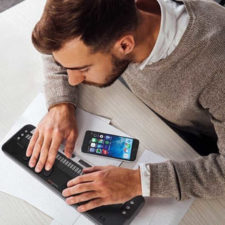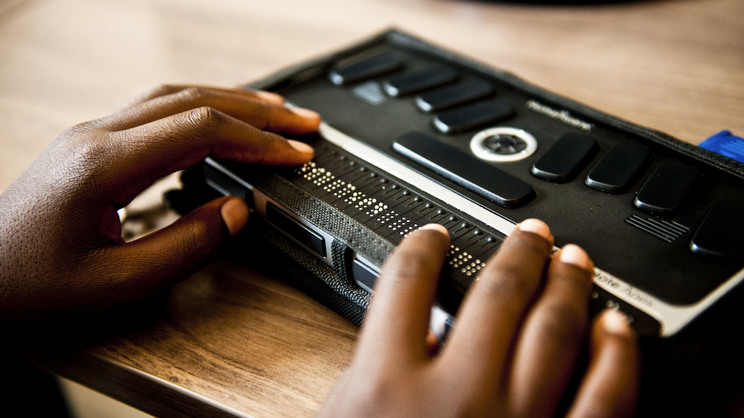OCR Devices for the Blind: Converting Print to Speech in Real-Time
OCR Devices for the Blind: Converting Print to Speech in Real-Time
Blog Article
Discover Ingenious Devices Designed for the Aesthetically Impaired
The growth of cutting-edge devices for the visually impaired stands for a significant innovation in availability and freedom. Technologies such as smart glasses with AI capabilities and mobile applications made to supply auditory summaries are reshaping everyday experiences for users.
Smart Glasses for Navigation

Smart glasses developed for navigating are reinventing the means visually damaged people engage with their atmosphere. These sophisticated gadgets utilize a combination of camera modern technology, synthetic knowledge, and acoustic feedback to provide real-time details concerning surroundings. By employing barrier detection systems, smart glasses can signal individuals to possible threats, making it possible for safer flexibility in both familiar and unfamiliar settings.
The assimilation of GPS technology further boosts navigating capabilities, permitting individuals to obtain auditory directions as they move. This hands-free approach not only promotes freedom but additionally empowers visually damaged individuals to browse urban landscapes with enhanced self-confidence. Furthermore, several smart glasses are furnished with attributes that recognize landmarks and street indicators, providing contextual details that boosts the customer experience.
In addition, the advancement of these tools is constantly progressing, with firms working to boost the precision of object recognition and expand the variety of navigational functions. As clever glasses end up being much more easily accessible and economical, they hold the possible to substantially transform life for aesthetically damaged users. Inevitably, these cutting-edge devices stand for a critical action towards inclusivity, offering enhanced movement and a greater sense of autonomy for people navigating the world around them.

Mobile Apps for Daily Living
Just how can mobile applications enhance the every day lives of aesthetically damaged people? Mobile apps are reinventing the method visually damaged customers navigate their settings, take care of day-to-day tasks, and access details. These applications offer crucial assistance through different performances, fostering self-reliance and enhancing quality of life.
A number of cutting-edge mobile apps are made especially for day-to-day living. As an example, apps like Be My Eyes attach aesthetically damaged customers with sighted volunteers using video telephone calls, allowing them to receive real-time help with tasks such as reading tags or navigating unknown areas. Seeing AI, created by Microsoft, uses fabricated knowledge to describe environments, checked out message, and determine objects, properly changing a smart device into an effective device for daily aid.
In addition, navigating apps tailored for the visually damaged, such as Aira and BlindSquare, provide audio-based directions and ecological information, enabling users to traverse their surroundings securely and confidently. Beyond navigating and instant support, mobile apps likewise sustain company and task management, with functions that aid customers establish pointers, develop to-do checklists, and track visits. In recap, mobile applications work as indispensable resources, empowering aesthetically impaired people to lead even more independent and meeting lives.
Wearable Technologies for Help
Empowerment via modern technology is significantly apparent in the world of wearable gadgets made to aid visually damaged people. These cutting-edge devices integrate effortlessly into life, enhancing navigation and supplying essential responses to click to read more users. For example, smart glasses equipped with video cameras can check out and identify faces text out loud, allowing users to connect more with confidence in social and specialist settings.
One more notable advancement is the usage of haptic responses systems in wearable devices. These systems utilize vibrations or various other responsive signals to share information concerning the customer's environment, such as obstacles or modifications in terrain, enhancing wheelchair and safety. Wearable innovations also include wristbands that connect to smartphones, informing users to notifications with refined resonances, thus enhancing connectivity without dependence on visual cues.
As these modern technologies remain to progress, they are not only boosting self-reliance for visually impaired people however likewise promoting a better feeling of addition in culture. By connecting the gap in between difficulties dealt with in daily living and the capacity for autonomy, wearable modern technologies offer as crucial devices in the mission for equality and empowerment for those with aesthetic problems.
Audio Description Tools
Sound description devices play an essential duty in improving access for aesthetically damaged individuals, giving them with the ability to engage with visual media. Assistive technology for the blind. These devices provide narrated descriptions of essential aesthetic aspects in films, tv programs, and live efficiencies, guaranteeing that customers can completely comprehend the context and emotions communicated through visuals
Sound description can be incorporated right into various systems, consisting of streaming services, movie theater testings, and live theater. Several preferred streaming services currently include audio summary as an access attribute, allowing viewers to choose it quickly. In addition to traditional media, specialized applications likewise exist, giving audio summaries for art exhibitions, galleries, and other cultural events.
The effectiveness of next audio summary depends upon the ability of the storytellers, that need to share visual information succinctly without interfering with the original audio. Developments in this field are additionally leading the way for more customized experiences, where users can readjust the level of detail and pacing according to their preferences.
Braille Innovations and Instruments
Braille gadgets and technologies have considerably changed the way aesthetically impaired individuals interact with message and info. Modern improvements have led to the development of versatile tools that boost literacy and self-reliance among individuals.
Additionally, portable Braille notetakers combine standard Braille input with modern capabilities, helping with note-taking, organizing, and paper editing on the move. Braille displays and notetakers. These portable gadgets often include text-to-speech capabilities, linking the gap between Braille and acoustic info
Furthermore, innovative Braille printers have actually emerged, allowing individuals to generate Braille labels, records, and instructional products effectively. This availability promotes better participation in educational and expert atmospheres, eventually promoting inclusivity.
Moreover, study right into smart Braille technologies remains to expand. Tools that incorporate expert system are being explored to offer real-time navigation aid and contextual details, boosting the user experience in diverse setups. Generally, these advancements reflect a dedication to empowering visually damaged individuals with technology, ensuring they can easily gain access to and engage with the globe around them.

Conclusion
The advancement of innovative devices for the aesthetically impaired considerably enhances freedom and quality of life. These modern technologies not only foster greater incorporation however additionally promote autonomy in day-to-day activities, eventually contributing to a much more accessible and equitable culture for visually damaged people.
As smart glasses come to be more easily accessible and economical, they hold the potential to considerably change day-to-day life for aesthetically impaired customers. Mobile applications are reinventing the method aesthetically damaged customers navigate their environments, take care of day-to-day tasks, and accessibility info. Applications like Be My Eyes link visually damaged customers with sighted volunteers through video calls, allowing them to get real-time assistance with tasks such as reading labels or browsing unfamiliar rooms.Additionally, navigation applications tailored for the aesthetically damaged, such as Aira and BlindSquare, supply audio-based directions and environmental details, allowing individuals to traverse visit their surroundings securely and confidently.The innovation of innovative devices for the aesthetically impaired dramatically improves freedom and high quality of life.
Report this page